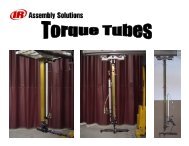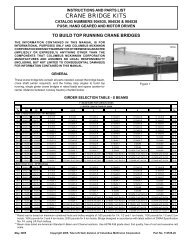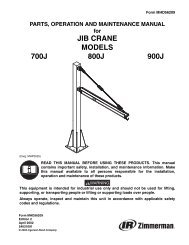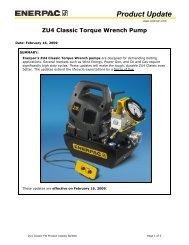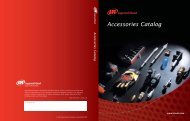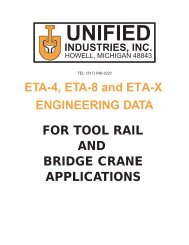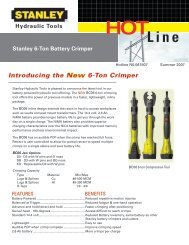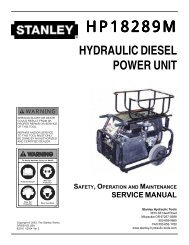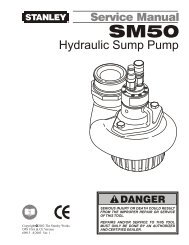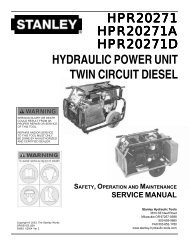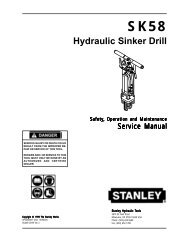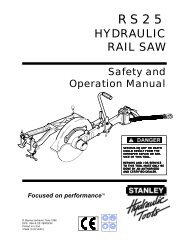Mobile Hydraulic Power Unit Safety, Operation and ... - Tool-Smith
Mobile Hydraulic Power Unit Safety, Operation and ... - Tool-Smith
Mobile Hydraulic Power Unit Safety, Operation and ... - Tool-Smith
Create successful ePaper yourself
Turn your PDF publications into a flip-book with our unique Google optimized e-Paper software.
OPERATION<br />
Location of Instruments, Switches, <strong>and</strong><br />
Controls<br />
NOTE: Use caution when operating or ordering items 3 & 7 they<br />
can come installed oppisite of what is illustrated above. The<br />
Bed up/down switch is spring loaded <strong>and</strong> will return to the<br />
center position when released. The tool ciucuit on/off switch<br />
is either on or off (2 way) no center position.<br />
9<br />
5<br />
1. Left & Right Track Controls for Forward, Reverse,<br />
<strong>and</strong> Left, Right Steering<br />
2. Throttle<br />
3. <strong>Tool</strong> Circuit ON/OFF Switch<br />
4. Hour Meter<br />
5. Key Ignition<br />
6. Warning Lights<br />
7. Bed UP/DOWN Switch<br />
8. Choke<br />
9. <strong>Tool</strong> Circuit Controls<br />
10. Fuel Shutoff<br />
Starting The Engine<br />
4<br />
1. Ensure the tool circuit control lever(s) are in the OFF<br />
position <strong>and</strong> the tool circuit switch is in the OFF<br />
position.<br />
2. Pull the choke out until it stops.<br />
1<br />
7<br />
10<br />
3. Move the throttle to a position between "SLOW"<br />
<strong>and</strong> "FAST".<br />
4. Turn the ignition key clockwise to begin cranking<br />
the engine. Use short starting cycles (15 seconds per<br />
minute) to prolong starter life. Extended cranking can<br />
2<br />
3<br />
8<br />
6 9<br />
damage the starter motor.<br />
5. After the engine starts, allow it to warm-up for a few<br />
seconds before moving the choke. Move the choke<br />
inward in small steps to allow the engine to accept<br />
small changes in speed <strong>and</strong> load. Continue moving<br />
the choke in until it is fully off <strong>and</strong> the engine is<br />
running smoothly.<br />
6. Adjust the throttle for the work to be done. See<br />
"Adjusting Throttle For Various Types of Work".<br />
Stopping The Engine<br />
1. Move the throttle to the "SLOW" position.<br />
2. Ensure the tool circuit control lever(s) are in the OFF<br />
position <strong>and</strong> the tool circuit switch is in the "OFF"<br />
position.<br />
3. Turn the ignition key counter clockwise to the<br />
"OFF" position.<br />
Adjusting Throttle for Various Types of<br />
Work<br />
Forward Travel<br />
The throttle can be positioned anywhere between<br />
"SLOW" <strong>and</strong> "FAST" for traveling forward depending<br />
on the weight of the load being carried. Heavy<br />
loads will require higher throttle settings in order for<br />
the engine to provide enough power to move the<br />
load.<br />
Reverse Travel<br />
Position the throttle to "SLOW" for reverse travel to<br />
permit increased control <strong>and</strong> safety.<br />
DO NOT attempt to travel in reverse with the<br />
throttle positioned above "SLOW". This may<br />
result in loss of control <strong>and</strong> result in injury<br />
or death to the operator.<br />
Bed Cylinder<br />
The throttle may be positioned anywhere between<br />
"SLOW" <strong>and</strong> "FAST" when operating the bed.<br />
<strong>Tool</strong> Circuit<br />
The throttle must be positioned to "FAST" when<br />
using the tool circuit. Slower throttle settings will<br />
stall the engine or provide reduced oil flow.



